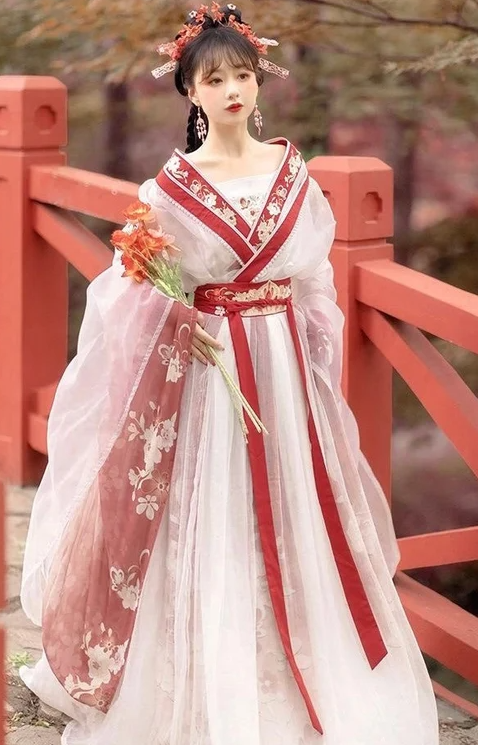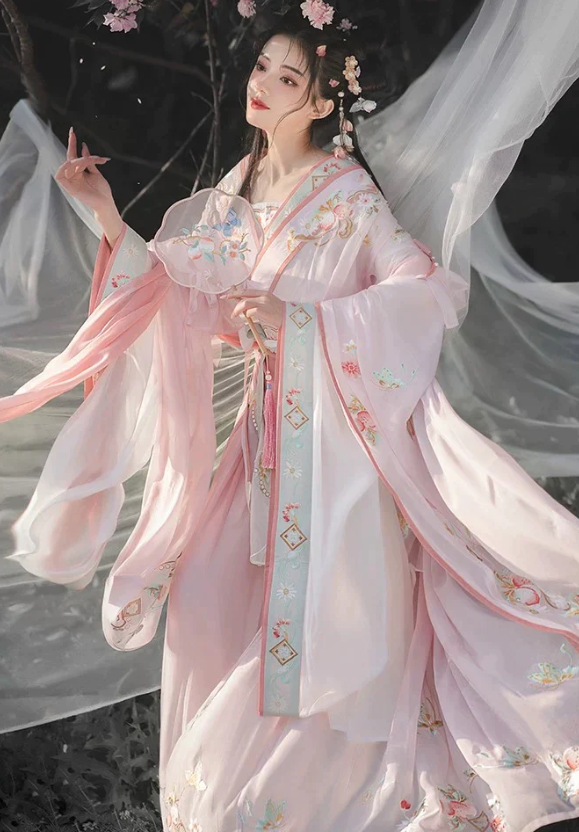Hanfu originated from China and is deeply tied to its cultural and historical traditions.
Historical Origins of Hanfu
Ancient Beginnings
The term ‘Hanfu’ itself derives its name from the Han Dynasty, emphasizing its deep-rooted association with Chinese culture.

Evolution over Time
As China went through various dynastic changes, so did Hanfu styles. The Tang Dynasty (618-907 CE) was a particularly noteworthy period for Hanfu.Subsequently, during the Ming Dynasty (1368-1644 CE), Hanfu saw a resurgence in its traditional styles, characterized by long flowing robes and wide sleeves. However, when the Qing Dynasty took over, they enforced the wearing of Manchu styles, resulting in a decline in the popularity of Hanfu. It wasn’t until modern times that Hanfu started to make a comeback, fueled by a renewed sense of cultural pride and Chinese nationalism.
Geographic Significance: Hanfu and China
Regional Variations
Hanfu is not a monolithic term that refers to just one type of clothing; it captures a variety of styles influenced by the diverse geography of China. For instance, in the colder northern regions, Hanfu tends to have thicker materials and longer sleeves, suitable for a more frigid climate. In contrast, the southern styles usually consist of lighter fabrics like silk, perfect for the humid and subtropical conditions. In Sichuan Province, known for its rich culture and history, Hanfu integrates elements of local artistry like Sichuan embroidery. These regional variations not only reflect the geographic diversity but also represent the rich tapestry of Chinese culture.
Influence on Surrounding Areas
The reach of Hanfu extends far beyond China’s borders. Its influence can be seen in the traditional clothing styles of neighboring countries. For example, the Korean Hanbok and the Japanese Kimono both bear resemblances to Hanfu in terms of their basic structure, although each has evolved to represent its unique cultural identity.
Hanfu Through the Dynasties
Han Dynasty Styles
The term ‘Hanfu’ originates from the Han Dynasty, which reigned from 206 BCE to 220 CE. This period established the foundational styles of Hanfu, with variations like the Shenyi and Ruqun becoming popular. The Shenyi was a one-piece robe, while the Ruqun consisted of a top and a skirt. The typical Han Dynasty Hanfu was designed with a cross-collar, tied with a sash, and the skirt was fastened in such a way that the length could be adjusted. Wearing these styles conveyed social status, occupation, and even philosophical beliefs. The designs and styles from this period served as a model for subsequent generations, encapsulating core elements of Chinese culture.
Ming Dynasty Influence
Fast forward to the Ming Dynasty, which spanned from 1368 to 1644 CE, and we see another burst of creativity in Hanfu styles. The Ming Dynasty embraced Han Chinese traditions after overthrowing the Mongol-led Yuan Dynasty. Ming-style Hanfu often featured round collars and straight lapels, with dragon and floral embroidery denoting the rank and status of the wearer. These elements have seen a revival in modern Hanfu trends.
Qing Dynasty and Its Impact
The Qing Dynasty (1644–1912) brought about a drastic change in Hanfu fashion, mainly due to the Manchu rule. The Manchu rulers implemented the Queue Order, which forced Han Chinese men to adopt Manchu hairstyles and clothing. As a result, traditional Hanfu styles saw a decline during this period, being replaced by the Manchu qipao and magua. However, the end of the Qing Dynasty also marked the end of imperial China, paving the way for modern interpretations of Hanfu. While the Qing Dynasty did inhibit the growth of Hanfu, it also contributed to its complexity and the cultural conversations surrounding it, serving as a crucial chapter in the story of Chinese nationalism.
Hanfu in Modern China
Revival Movement
The late 20th and early 21st centuries have witnessed a renaissance of Hanfu styles, a movement often credited to the rise of Chinese nationalism and cultural pride. Young Chinese people, in particular, have embraced Hanfu, donning it for special occasions, photoshoots, and even everyday wear. This revival movement aims to bring back the significance of Hanfu as a symbol of pure Han culture, distinct from the influences of other ruling minorities throughout history. Universities have Hanfu clubs, and social media platforms are filled with Hanfu influencers, showcasing a range of styles from different dynasties. This renaissance taps into a yearning for cultural revival and the reestablishment of Chinese traditional values.
Hanfu in Modern Fashion
Today, fashion designers and brands are integrating Hanfu styles into modern clothing. Traditional elements like embroidery, flowing robes, and intricate patterns often make appearances on high-fashion runways and street fashion alike. These designs appeal not just to history buffs but also to fashion-forward individuals looking for a unique aesthetic. Brands both domestic and international see the value in incorporating elements of Hanfu, signaling its widespread appeal.
Role in Cultural Identity
Hanfu serves more than just a stylistic purpose; it plays a significant role in defining cultural identity in modern China. Wearing Hanfu is often considered an act of cultural reaffirmation, allowing individuals to connect with their heritage on a deeper level. The garment becomes a walking narrative, telling stories of different dynasties, regional influences, and historical symbolism. As younger generations grow increasingly interested in their roots, the role of Hanfu in shaping Chinese identity becomes all the more relevant.
Cultural Importance of Hanfu
Symbolism in Design
Every stitch and fold in Hanfu carries meaning, steeped in centuries of tradition. The embroidery patterns also carry symbolic weight: dragons symbolize imperial power, while cranes represent longevity and good fortune. These aren’t just artistic choices; they are a narrative of the values, beliefs, and aspirations of the Chinese people. Understanding this symbolism gives a richer, more nuanced appreciation for Hanfu, making it a visual representation of Chinese philosophy and cultural values.

Hanfu in Festivals and Rituals
Hanfu isn’t just for fashion; it plays a critical role in various Chinese festivals and rituals. During Lunar New Year celebrations, the Spring Festival, and other traditional holidays, Hanfu becomes a popular choice for many as they visit temples, greet relatives, and participate in festivities. Even in important life rituals such as weddings, the bride and groom might choose to wear Hanfu, embracing the attire’s auspices of good luck and blessing. During the Dragon Boat Festival, another significant event, people wearing Hanfu participate in various traditional activities like dragon boat racing and making zongzi (sticky rice wrapped in leaves). The role of Hanfu in these events showcases its importance as not just clothing but a living aspect of Chinese tradition.